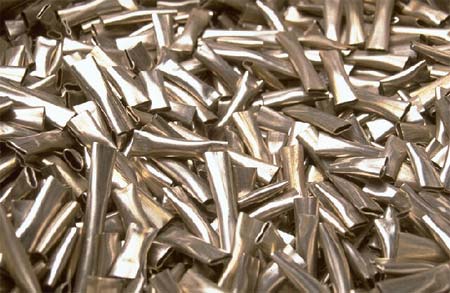Intermediate-level waste (ILW-LL)
Intermediate-level long-lived waste (ILW-LL)

Irradiated hulls and end-pieces
These hulls and end-pieces are the residue of the zircaloy cladding that surrounds fuel pellets. They have been heavily irradiated while spending three years in a reactor and are therefore radioactive. They form part of the ‘intermediate-level’ waste. They will be sent to the technological waste compaction and reduction facility at the La Hague plant.
© PHILIPPE LESAGE /AREVA
The French classification system uses ILW-LL to refer to waste with an activity level considered to be intermediate but that has a long life span. It lies between LILW-SL, with low levels of activity, and HLW, with very high levels of activity. Regulations require that it is between 0.01 and 10 Curies per kg, much more than low-level waste, but much less than high-level waste.
Most ILW-LL waste in France comes from reprocessing. For example, the cladding and end-pieces of fuel assemblies that have been cut so that the irradiated uranium oxide pellets can be taken out, are intermediate-level waste. Their radioactivity is due to contamination with radioactive atoms, some of which have half-lives of more than a thousand years. These characteristics mean they have to be managed separately using long-term solutions.

Change in radioactivity of an intermediate-level package
The radioactivity of ILW-LLpackage is generally between one million and one billion becquerels per gram. The change in activity over time of an ILW-LL package, such as a container holding compacted ‘cladding waste’ from spent fuel reprocessing, follows the same general pattern as that of vitrified waste, but the initial activity level is obviously lower. The average thermal output of this type of waste is initially about twenty watts per waste package but it decreases by a factor of 10 over a century.
© ANDRA
As well as cladding, hulls and end-pieces, ILW-LL also includes insolubles, filters and resins, the products of sedimentation and centrifuging, and sludge from purification during reprocessing. There are also materials that have become contaminated during operation or maintenance, such as clothing, tools and spare parts. Eventually this waste will also include the most radioactive elements from the future dismantling of reactors.
Until recently, ILW-LL was encapsulated in an inert material: bitumen or concrete. In France the hulls and end-pieces are now compacted into pucks and placed in stainless steel containers similar to those used in vitrification facilities. This standardisation makes it easier to maintain, transport and dispose of them.
ILW-LL waste accounts for 3% of the volume and 4% of the activity of all radioactive waste. French reactors produce approximately 2800 m³ of low- and intermediate-level long-lived waste every year. The cumulative volume of this waste will reach 100,000 m³ by 2020. It gives off little heat and therefore does not need to be cooled. In France it seems unlikely that deep geological disposal of this waste can be avoided because the life of some of the radioelements involved can be as much as tens of thousands of years.
Around 64% of ILW-LL has not yet been conditioned and is awaiting a final solution for its disposal. This waste, most of which is old, is stored at the CEA’s facilities at Cadarache and AREVA’s facilities at Marcoule and La Hague. It will have to be recovered and conditioned in accordance with current safety standards, for long-term management.
Other articles on the subject « Waste Classification »
High-level waste (HLW)
Spent nuclear fuels and vitrified waste High-level waste is waste for which management is a prior[...]
Low and intermediate-level waste
Low- and intermediate-level short-lived waste (LILW-SL) In France, the oldest disposal facility f[...]
Very low-level waste (VLLW)
VLLW: very low-level waste VLLW: the least radioactive category Very low-level waste (VLLW) sits [...]
Low-level waste (LLW-LL)
Low-level long-lived waste (LLW-LL) Low-level waste, which has a much lower level of activity tha[...]